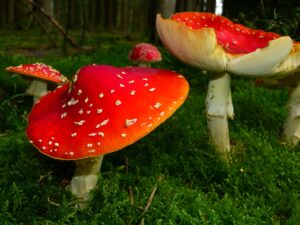While the Egyptians can claim the oldest surviving medical text in the world, the Kahun Gynaecological Papyrus from 1800 BCE (making it almost 4,000 years old), most historians agree that the oldest surviving system of medicine is ayurveda, originating in India. The word “ayurveda” contains the Sanskrit words ayur (life) and veda (science or knowledge). Combined, it means “The complete knowledge for long life.”
Though ayurveda can be documented to be at least 3,000 years old, most experts push that date to closer to 6,000 years of continuous practice, taking into account the millennia of medical knowledge handed down by word of mouth, prior to being written in texts.
Some of the key concepts in ayurvedic medicine surround the interconnectedness of people, health and the universe, which are indivisible one from the other. The body’s constitution (prakriti) and life forces (dosha) are similarly interconnected. In my opinion, one of the reasons ayurveda is still in successful practice today is because it is not only effective, it is a truly holistic practice, with individualized treatments that incorporate natural medicines, diet, exercise and lifestyle changes. An ayurvedic practitioner from hundreds of years ago might find him or herself quite at home in a modern holistic, integrative medical practice of today.
There are eight branches of ayurveda, including pediatrics, surgery, health and longevity and toxicology; and three theories: pancha mahabhuta (five elements), tri-dosha (three body humors) and sapta-dhatu (seven body tissues). Perfect balance yields perfect health, and illness is caused by imbalance. Health is considered the natural state, and illness is created by anything that disrupts our natural state. An important precept of ayurveda is that people make choices, and when poor choices are made, imbalance occurs, resulting in sickness.
Ayurveda at its best is a way of life—of choosing healthy practices in both body and spirit to attain ongoing balance. Unlike Western medicine, it is not a one-time intervention to fight a single disease, but rather life-long changes that return the patient to vibrant physical and emotional health. That said, many of the medicines used in ayurveda are dually powerful, offering both excellent prevention of disease, and intervention should disease occur.
Validation
India’s current population is 1.26 billion people, the second most populous country in the world. That is nearly four times the population of the United States. In India, ayurveda is considered a legitimate health-care system, and both practitioners and schools of ayurveda are licensed by the state. Upwards of 70 percent of the rural population rely on ayurveda as primary health care. It is not considered “alternative” or “complementary.” It is mainstream medicine, and has been for a long time.
However, the majority of people in the United States are neither familiar with nor using ayurveda. In fact, the National Center for Complementary and Alternative Medicine (NCCAM) reports that in a 2007 survey, only about 200,000 Americans stated they had used ayurvedic medicine in the previous year. This government organization stated, “Most clinical trials of ayurvedic approaches have been small, had problems with research designs or lacked appropriate control groups, potentially affecting research results.” This difference in perspective—almost universal acceptance as mainstream medicine in India vs. caution and declarations of not enough clinical validation in the opinion of Western medicine—is not conducive to enlightened exchanges of ideas and best practices.
According to noted botanical medicine investigator, author, and ethnobotanist Chris Kilham, often called The Medicine Hunter, “The five-thousand-year-old system of ayurveda, which is not only the oldest articulated system of health care in the world, but also highly sophisticated, employing herbs, foods, cleansing regimes, physical therapies, yoga and meditation to restore harmony and well-being. Ayurveda is comprehensive, and truly holistic. It works.”
Medicinal Herbs Originating from Ayurveda
Though acceptance of ayurvedic medical practice may not be full-scale in the United States, certain herbs that are mainstays of ayurveda are beginning to be recognized as powerful natural medicines.
Ashwagandha (Withania somnifera) is a highly valued herb originating in ayurveda. Its name means “smells like a horse,” but it is also sometimes called “Indian Ginseng” because of its profound adaptogenic properties. Adaptogens are rare medicines that move the body toward health. That means they somehow adjust to the specific needs of the body, and can raise or lower certain physical parameters accordingly. For example, in a person with low adrenal function, this valuable, clinically studied herb can improve energy and stamina, but in a person with a great deal of stress and excessive cortisol release from the gland, ashwagandha lowers cortisol and helps a person calm down and relax.
There are 688 studies listed on the National Institutes of Health (NIH) electronic PubMed (www.PubMed.gov) on ashwagandha, for a wide array of illnesses, including cancer, database, called neurodegenerative disease, kidney damage associated with diabetes, pain, gout, abnormal blood clots, anxiety, depression and even healthy sexual function. In my opinion, ashwagandha makes you stronger, more resistant to both physical and psychological stressors, and greatly improves both energy and endurance, probably because of its impact on adrenal function.
Not all ashwagandha is created equal. It is important to know the standardization of withanolides (key compounds in the plant, and should be at least 5 percent) and purity. Because of extreme variations in raw materials, it is better to choose a form with published human clinical studies so benefits are more predictable and safety is better assured.
Boswellia is another effective medicine from ayurvedic practice. On the NIH study database, there are 346 studies on boswellia, sometimes called frankincense. Boswellia is made from the gum resin of the Boswellia serrata tree and has been shown to have a unique and powerful property: it can modulate an inflammatory pathway in the body that no drug touches except for steroids. Called the 5-lipoxegenase (5-LOX) pathway, this type of inflammation does not respond to aspirin, ibuprofen, naproxen sodium or prescription drugs like celecoxib (Celebrex) or diclofenac sodium (Voltaren), all of which target a kind of inflammation called COX-2. There are many 5-LOX inflammatory diseases that are difficult to treat, including asthma, chronic obstructive pulmonary disease (COPD), emphysema and chronic bronchitis, where boswellia may be an excellent choice. Arthritis, gout, inflammatory bowel, Crohn’s and ulcerative colitis are also partially mediated by 5-LOX, so boswellia is useful in combination with other herbs in these instances as well.
The best boswellia is standardized to a minimum of 10 percent of a very active anti-inflammatory compound called acetyl-11-keto-beta-boswellic acid (AKBA). Unstandardized boswellia can have as little as 1 percent. Also, boswellia contains a problematic compound that actually causes inflammation, so it should be purified to remove beta boswellic acid (BBA) to less than 5 percent for the highest benefits. Clinically studied and standardized boswellia is more powerful and specific to inflammatory targets than unstandardized varieties.
These are just two herbs with an impressive history of effectiveness, but there are many more health treasures used in this holistic medical system. If you are interested in the practice of ayurveda, one organization that provides direction is the National Ayurvedic Medical Association (www.ayurvedanama.org), which lists information and referrals on their website. Though it is more a resource for ayurvedic practitioners, the Association of Ayurvedic Professionals of North America, Inc. (http://aapna.org), offers a number of articles and information on learning more about ayurveda. VR
References:
Ancient History Encyclopedia: Medicine. Available at: http://www.ancient.eu/medicine/
NIH: National Center for Complementary and Alternative Medicine (NCCAM). Ayurvedic Medicine: An Introduction. http://nccam.nih.gov/health/ayurveda/introduction.htm
Ayurveda–modern medicine interface: A critical appraisal of studies of Ayurvedic medicines to treat osteoarthritis and rheumatoid arthritis. Arvind Chopra, Manjit Saluja, and Girish Tillu. J ayurveda Integr Med. 2010 Jul-Sep; 1(3): 190–198.
IndiaStat. Available at: http://www.indiastat.com/searchresult.aspx
National Bureau of Statistics China. Available at: http://data.stats.gov.cn/
PBS’ ayurveda 101. Available at: http://www.pbs.org/frontlineworld/stories/india701/interviews/ayurveda101.html
National Ayurvedic Medical Association. Available at: http://www.ayurvedanama.org
Chris Kilham. Private communication (email) on November 20th, 2014.
Cheryl Myers is an integrative health nurse, author, and an expert on natural medicine. She is a nationally recognized speaker who has been interviewed by the New York Times, Wall Street Journal and Prevention magazine. Her many articles have been published in such diverse journals as Aesthetic Surgery Journal and Nutrition in Complementary Care, and her research on botanicals has been presented at the American College of Obstetrics and Gynecology and the North American Menopause Society. Myers is the head of Scientific Affairs and Education for EuroPharma, Inc.













